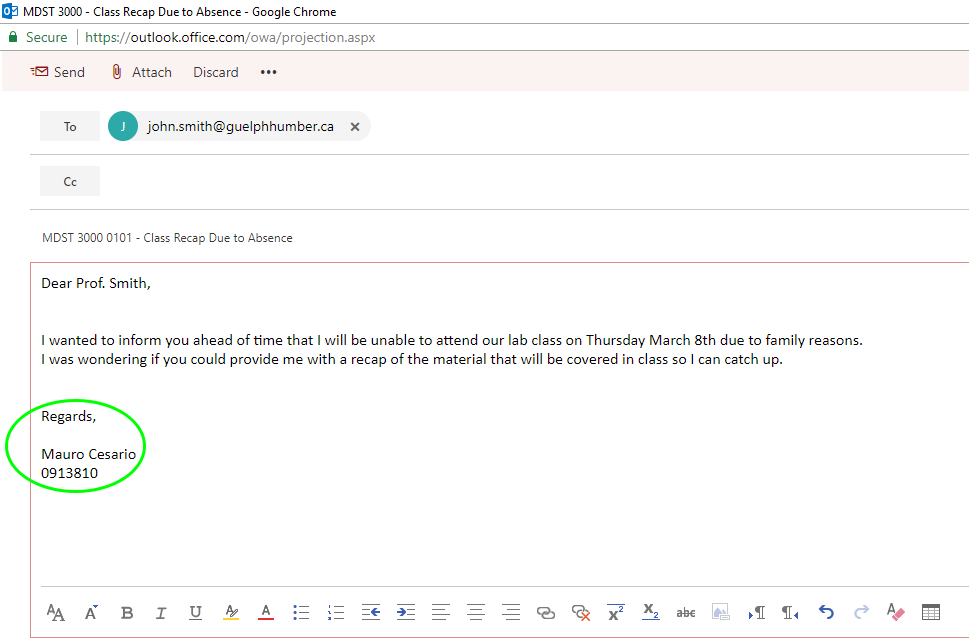Professionalism is a broad concept, but it all boils down to the same thing: the representation of self. Whether you are speaking with your boss or writing an email, to be professional is not only to show others who and what you are, but HOW you are.
Usually, it is best if you meet with someone face-to-face, that way, you both know the intentions behind each other’s words and you can clearly get your message across.
This shifts when it comes to writing an e-mail. You have to be careful about what you say.
Whether you’re in college or university, professors expect you to be professional not only by your looks but also by the way you communicate- especially through e-mail;
John’s essay is due tomorrow. He writes an e-mail to his professor asking for an extension;
“Hi Prof. Katie I need an extension for the essay due tomorrow it’s been crazy thanks a bunch and see you soon.”
John will either get a bad response or NO response at all. Starting from the salutation to having no punctuation at all, this e-mail is a recipe for disaster.
E-mail is almost always the only way to talk to your professor when you need help. Mastering the art of writing a professional email would not only help John get a reply back, but you as well.
Professors appreciate a well written e-mail. This means being clear, to the point and respectful.
But why write a professional e-mail in the first place?
Media studies professor Heather Goode at the University of Guelph-Humber says that an email is important because; “it shows the person whether you are professional or not, it is their first impression of you.”
Just like meeting with someone face-to-face, an e-mail can replace the way people see you in person. The problem with an e-mail is that the person receiving the e-mail can misinterpret the words. Unlike a one-on-one, an e-mail doesn’t show others your message as clearly as possible.
Jonathan Obar, Communication Studies professor at York University says that it is important to write a clear and concise e-mail.
“Sometimes e-mail can be a way to miscommunication, unfortunately, because it’s just words on a page. I think that writing a professional e-mail not only communicates in its form but you are also doing the best you can in a complete way.”
He says that to write a professional e-mail is a sign of respect, courtesy and completeness. In a university or college setting, students and staff alike must continue to communicate effectively beyond the classroom, through professionalism.
Writing a bad e-mail can give you either a negative response or no response at all.
Professor Goode said that she has received countless poorly written e-mails and that she would either talk to the person in class or not reply back at all.
“I’ve had e-mails sent to me with a one paragraph long without any punctuation. I have also received rude e-mails- most of the time when I get such e-mails it is a conversation in person or I simply don’t respond. This shows up in their professional conduct mark.”
Her philosophy for writing an e-mail is to take your time and remember that “if it isn’t something you’d like to see on the front page of the New York Times, then don’t bother writing it at all.”
If you want to get a reply back from your professor, then follow this step-by-step guide to writing a professional e-mail.
A Step-By-Step Guide to Writing a Professional E-Mail

Step 1: Make sure you have the correct e-mail of your professor
- Before moving toward the subject line of your e-mail, be sure that you have the correct spelling of the e-mail address
- Some professors may have more than one e-mail so ensure you are sending it to the one mentioned in class or on the course website

Step 2: Include the course code and section number in your subject line
- Professors teach multiple classes and receive several e-mails per week, so to give better context of your matter, begin the subject line with the course and section number
- Following the course number, give a brief description or topic of what your inquiry will entail

Step 3: Formally address your professor at the beginning of your message
- Remember that your professor is a person of authority and should be addressed just like any other professional
- Something as simple as “Dear Prof. Smith,” or “Hi Prof. Smith,” is a much more respectful address than “Hi John,”

Step 4: Be concise when speaking and ask your question(s) in a respectful tone
- Sometimes instructions are not entirely clear and you as a student are left either guessing or e-mailing the professor for further details
- Be clear and to the point with what you are asking and not mix words
- When asking for something such as clarification or with any matter, do not attack or come off aggressive towards your professor
- Use formal language, proper grammar and avoid slang and abbreviations AT ALL TIMES

Step 5: Provide a thank you or formal closing, including your name and student number
- After the body text of your email, consider a closing remark such as “Thank you”, “Regards,” or “Sincerely,”
- Students sometimes begin their e-mail introducing themselves towards the professor but always provide a closing that includes both your full name and student number

Step 6: Send the email and be patient when waiting for a reply
- It is easy to become frustrated when hours go by and you have not received a response
- Always allow at least 24 hours before sending a follow up e-mail to a professor
- If you do not receive a response within the next couple of days, consider sending a follow-up or ask the professor your question politely in-person